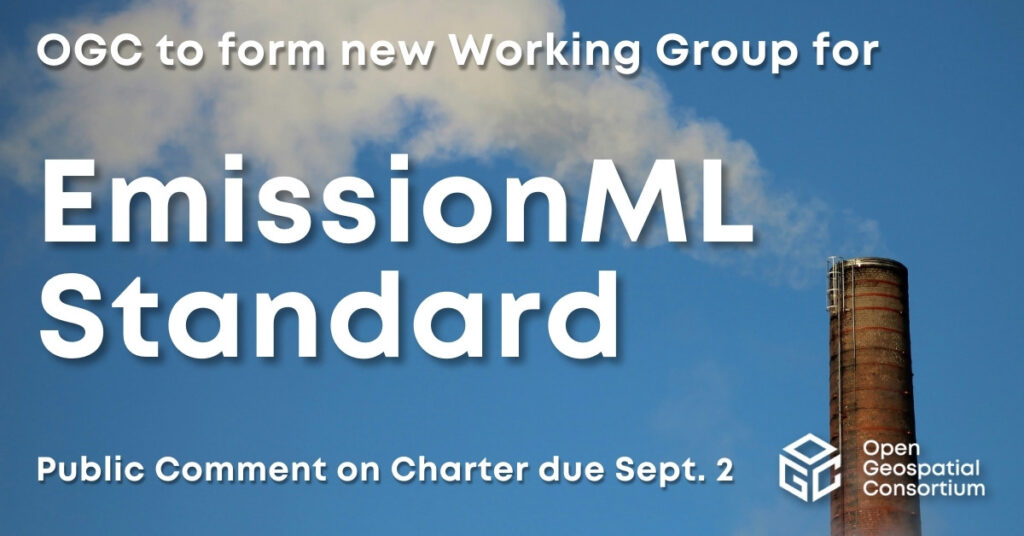Request Closed: August 12, 2024 9:00 am — September 2, 2024 11:59 pm
The Open Geospatial Consortium (OGC) membership seeks to form a new Emission Event Modeling Language Standards Working Group (EmissionML SWG). Public comment is sought on its draft Charter. Comments are due by September 2, 2024.
The proposed OGC EmissionML Standard seeks to address the data interoperability gap that exists between emissions, their associated sensor observations, and the geospatial features that are the sources of emissions.
Emissions refer to the release of pollutants, such as greenhouse gases and particulate matter, into the atmosphere from various sources, including industrial activities, transportation, and agricultural practices. Managing and reducing these emissions is crucial for mitigating climate change, protecting public health, and preserving the environment. The significance of emissions management lies in its ability to reduce the adverse impacts on air quality, global warming, and ecosystems. Typical types of emissions include carbon dioxide (CO2), methane (CH4), nitrous oxide (N2O), and sulfur dioxide (SO2), as well as volatile organic compounds (VOCs) and particulate matter (PM). Some emissions, such as Hydrogen Sulfide (H2S) and Carbon Monoxide (CO), can be extremely hazardous and have the potential to be fatal to humans. Effective emissions data management enables better monitoring, reporting, and regulatory compliance, ultimately contributing to a sustainable and healthier planet.
Using methane as an example, advancements in methane sensor technology, measurement methodologies, and regulatory requirements are rapidly evolving. This has highlighted a critical gap in the absence of standardized data models and encodings for streamlined analysis and reconciliation of methane emission data. Notably, existing methane reporting standards and regulations vary in their definitions of emissions and contextual data. These contextual data of methane emissions include but are not limited to: methane sensor observations, methane detections, uncertainties of the emissions in space/time/quantity, and related geospatial features that emit methane plumes, and more.
Potential use cases for the EmissionML Standards include:
- To enable emissions data exchange between the different data systems of regulators, sensing system providers, emissions management platform providers, field service operators, and researchers.
- To enable the exchange of observation data between emission sensing system providers, such as satellite data providers, airborne remote sensing providers, drone-based remote sensing providers, vehicle-based remote sensing providers, continuous monitoring system providers, and/or handheld Optical Gas Imaging (OGI) service providers.
- To enable improved reconciliation of top-down and bottom-up emissions measurements.
- To enable faster mitigation actions.
The Purpose of the EmissionML Standards Working Group (SWG) is as follows:
- To develop EmissionML, an abstract standard data model that enables the interoperable use of emission events, that can be extended for multiple emission types.
- Using this abstract data model, the SWG will then develop a portfolio of Open Standards that enable the interoperable use of spatiotemporal emission event data and relevant observations and procedures.
- More specifically the SWG will develop the Methane Emission Event Modeling Language (MethaneML) based on the EmissionML abstract data model, and demonstrate the interoperability and extensibility of the abstract model.
- The SWG will also develop new OGC Best Practices that define the uses of OGC Standards in order to enable the determination of the occurrence of emission events and estimation of the quantity of the emissions. Example OGC baseline Standards include but are not limited to OGC Observations, Measurements, and Samples (OMS), W3C/OGC Semantic Sensor Network Ontology (SSN), and more.
The draft Charter for the Emission Event Modeling Language (EmissionML) Standards Working Group (OGC 24-021r1) (.DOC) is available for review and comment on the OGC Portal. Comments are due by September 2, 2024, and should be submitted via the method below.
To Comment:
Comments can be submitted to a dedicated email reflector for a period ending on the “Close request date” listed above. Comments received will be consolidated and reviewed by OGC members for incorporation into the document. Please submit your comments via this email address, using this Comments Template for the message body.
Subscribe to Comments:
You may wish to subscribe to the distribution list to receive comments as they are submitted. Subscribing to the list will also allow you to view comments already received, which can be found in the List Archives.






